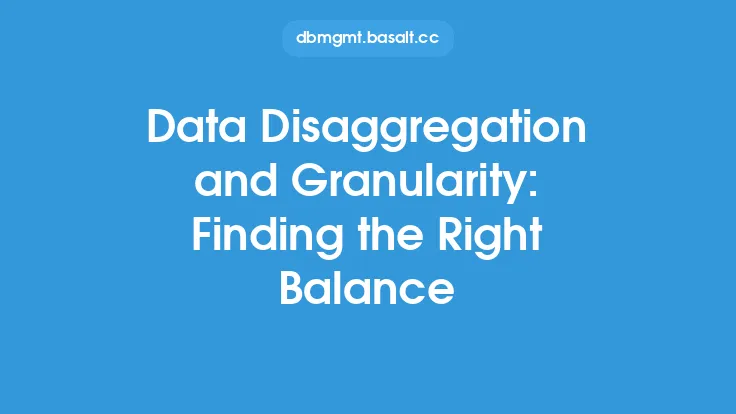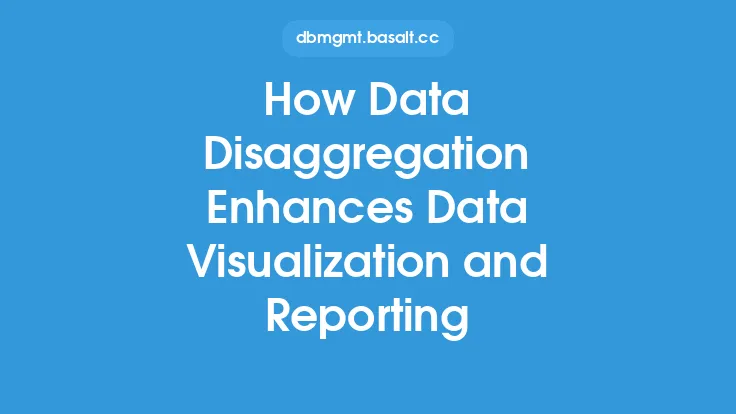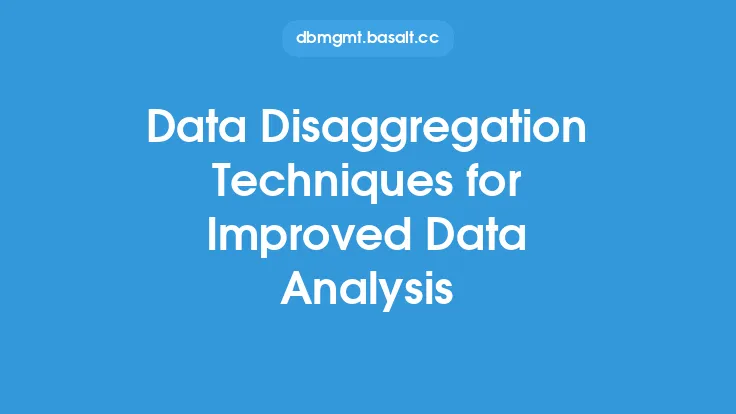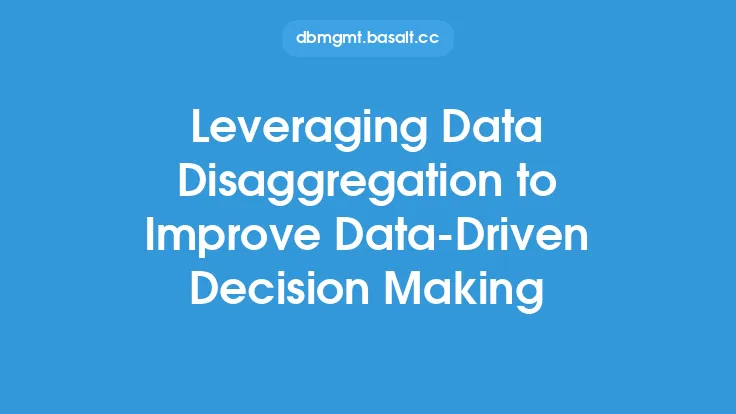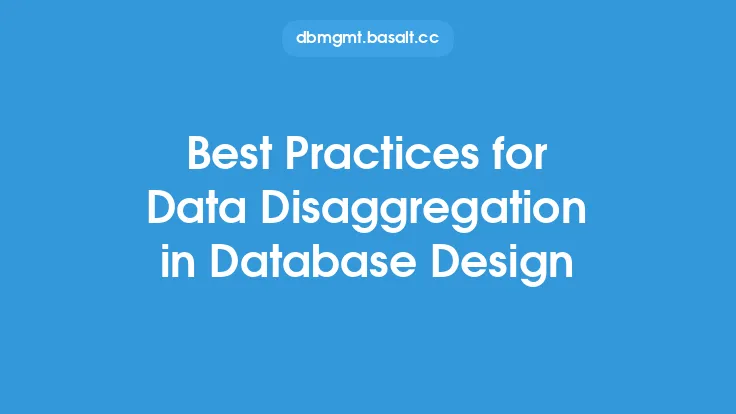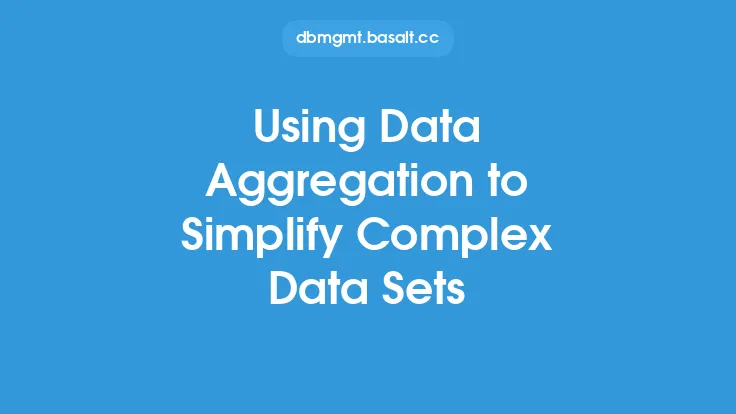Data normalization is a crucial process in data management that involves organizing and structuring data to minimize data redundancy and dependency. One of the key aspects of data normalization is data disaggregation, which involves breaking down complex data sets into smaller, more manageable pieces. In this article, we will delve into the concept of data disaggregation, its importance, and the various techniques used to achieve it.
Introduction to Data Disaggregation
Data disaggregation is the process of decomposing complex data sets into smaller, more granular components. This process involves identifying the individual elements that make up the data set and separating them into distinct categories. Data disaggregation is essential in data normalization as it helps to reduce data redundancy, improve data integrity, and enhance data analysis. By breaking down complex data sets, data disaggregation enables organizations to gain a deeper understanding of their data, identify patterns and trends, and make informed decisions.
Types of Data Disaggregation
There are several types of data disaggregation, including:
- Horizontal disaggregation: This involves breaking down data into smaller, more detailed components, such as separating customer data into individual customer records.
- Vertical disaggregation: This involves breaking down data into smaller, more specific components, such as separating sales data into individual product sales.
- Temporal disaggregation: This involves breaking down data into smaller, more time-specific components, such as separating sales data into daily, weekly, or monthly sales.
- Spatial disaggregation: This involves breaking down data into smaller, more location-specific components, such as separating customer data into individual regions or countries.
Benefits of Data Disaggregation
Data disaggregation offers several benefits, including:
- Improved data analysis: By breaking down complex data sets, data disaggregation enables organizations to gain a deeper understanding of their data and identify patterns and trends that may not be apparent at a higher level of granularity.
- Enhanced data integrity: Data disaggregation helps to reduce data redundancy and improve data integrity by ensuring that each piece of data is accurate and consistent.
- Increased data flexibility: Data disaggregation enables organizations to use their data in a variety of ways, such as creating customized reports, dashboards, and visualizations.
- Better decision-making: By providing a more detailed and accurate understanding of their data, data disaggregation enables organizations to make informed decisions that are based on reliable and trustworthy information.
Techniques for Data Disaggregation
There are several techniques that can be used for data disaggregation, including:
- Data partitioning: This involves dividing data into smaller, more manageable pieces based on specific criteria, such as date, location, or customer type.
- Data grouping: This involves grouping similar data elements together, such as grouping customer data by demographic characteristics.
- Data aggregation: This involves combining data elements to create a summary or total, such as calculating total sales for a given period.
- Data transformation: This involves converting data from one format to another, such as converting data from a text format to a numerical format.
Challenges of Data Disaggregation
While data disaggregation offers several benefits, it also presents several challenges, including:
- Data complexity: Complex data sets can be difficult to disaggregate, especially if they contain multiple variables and relationships.
- Data quality: Poor data quality can make it difficult to disaggregate data accurately, especially if the data contains errors or inconsistencies.
- Data volume: Large data sets can be difficult to disaggregate, especially if they contain millions or billions of records.
- Data security: Data disaggregation can create security risks, especially if sensitive data is being disaggregated and shared with multiple stakeholders.
Tools and Technologies for Data Disaggregation
There are several tools and technologies that can be used for data disaggregation, including:
- Data management software: This includes software such as database management systems, data warehousing tools, and data governance platforms.
- Data analytics software: This includes software such as statistical analysis tools, data visualization tools, and data mining software.
- Data integration software: This includes software such as data integration platforms, data migration tools, and data synchronization software.
- Cloud-based services: This includes cloud-based services such as data storage, data processing, and data analytics platforms.
Best Practices for Data Disaggregation
To ensure effective data disaggregation, organizations should follow several best practices, including:
- Define clear goals and objectives: Organizations should clearly define what they want to achieve through data disaggregation and ensure that their goals and objectives are aligned with their overall business strategy.
- Use appropriate techniques and tools: Organizations should use the most appropriate techniques and tools for data disaggregation, based on the complexity and volume of their data.
- Ensure data quality: Organizations should ensure that their data is accurate, complete, and consistent, and that it is properly validated and verified before disaggregation.
- Implement data security measures: Organizations should implement robust data security measures to protect sensitive data and prevent unauthorized access or disclosure.
Conclusion
Data disaggregation is a critical aspect of data normalization that involves breaking down complex data sets into smaller, more manageable pieces. By understanding the types, benefits, techniques, challenges, tools, and best practices of data disaggregation, organizations can unlock the full potential of their data and gain a deeper understanding of their business. Whether it's improving data analysis, enhancing data integrity, or increasing data flexibility, data disaggregation is an essential step in preparing data for analysis, reporting, and decision-making.
